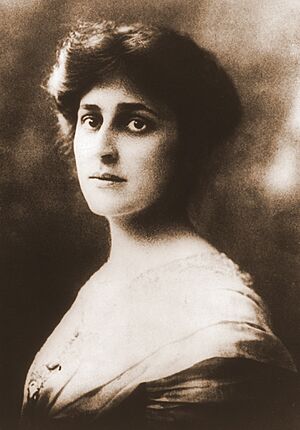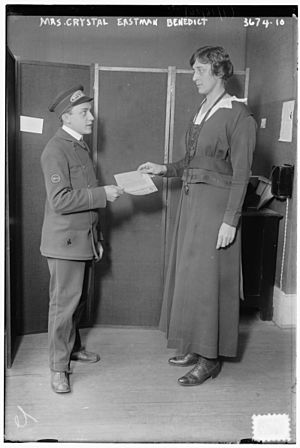Crystal Eastman facts for kids
Quick facts for kids
Crystal Eastman
|
|
|---|---|

Eastman, c. 1914
|
|
| Born |
Crystal Catherine Eastman
June 25, 1881 |
| Died | July 8, 1928 (aged 47) |
| Nationality | American |
| Occupation | Lawyer |
| Known for | Feminism, socialism, Congressional Union for Woman Suffrage, The Liberator, and as a co-founder of both the Women's International League for Peace and Freedom and American Union Against Militarism |
| Spouse(s) | Wallace Benedict, Walter Fuller |
| Children | Jeffrey Fuller and Annis Fuller |
| Parent(s) | Samuel Elijah Eastman and Annis Bertha Ford |
| Relatives | Max Eastman (brother) |
Crystal Catherine Eastman (born June 25, 1881 – died July 28, 1928) was an American lawyer, writer, and activist. She worked hard for many important causes. These included women's right to vote, peace, and civil liberties (basic rights for all people).
She helped start important groups like the Women's International League for Peace and Freedom and the American Civil Liberties Union. With her brother Max Eastman, she also co-edited a magazine called The Liberator. In 2000, she was honored in the National Women's Hall of Fame.
Contents
Early Life and Education
Crystal Eastman was born in Marlborough, Massachusetts, on June 25, 1881. She was the third of four children. Her parents, Samuel Elijah Eastman and Annis Bertha Ford, were both Protestant ministers.
In 1883, her family moved to Canandaigua, New York. Her mother became one of the first women ministers in America. Crystal grew up in an area known for people fighting for social change, like ending slavery. This background influenced her and her younger brother, Max. They both became activists for important causes.
Crystal and Max were very close throughout their lives. They lived together for some years in Greenwich Village in New York City. This area was a hub for many other activists and artists.
Crystal was a very smart student. She graduated from Vassar College in 1903. She then earned a master's degree in sociology from Columbia University in 1904. In 1907, she earned her law degree from New York University Law School. She finished second in her class.
Fighting for Social Change
Crystal Eastman's first job was to study working conditions for a project called The Pittsburgh Survey. She wrote a report called Work Accidents and the Law in 1910. This report was very important. It led to the first workers' compensation law in New York. This law helped workers who got hurt on the job.
She kept working to make workplaces safer and healthier. She also believed that mothers of young children should receive financial support. She felt this would help women be more independent and have more economic power.
Working for Women's Rights
Crystal Eastman was a strong leader in the fight for women's right to vote. In 1912, she helped manage a campaign for women's suffrage in Wisconsin.
In 1913, she joined Alice Paul and Lucy Burns to start the Congressional Union. This group later became the National Woman's Party. They worked hard to get women the right to vote across the country.
After the 19th Amendment was passed in 1920, giving women the right to vote, Crystal Eastman and Alice Paul wrote the Equal Rights Amendment (ERA). This amendment aimed to make sure women had the same rights as men under the law. Crystal believed the ERA was very important for achieving full equality. She gave a famous speech called "Now We Can Begin," where she talked about the work still needed for gender equality.
Efforts for Peace

During World War I, Crystal Eastman was a founder of the Woman's Peace Party. This group later became the Women's International League for Peace and Freedom. It is still an active women's peace organization today.
She also became a leader of the American Union Against Militarism. This group worked to keep America out of the war in Europe. They also worked against forcing people to join the military.
When the United States entered World War I, Crystal helped create the National Civil Liberties Bureau. This group aimed to protect the rights of people who refused to fight in the war because of their beliefs. This bureau later grew into the American Civil Liberties Union (ACLU), which still works to protect everyone's civil rights.
Family and Later Life
In 1916, Crystal married Walter Fuller, a British editor and peace activist. They had two children, Jeffrey and Annis. They worked together as activists for a time. Walter later returned to England and died in 1927.
After her brother Max Eastman's magazine The Masses was shut down, he and Crystal started a new magazine together. It was called The Liberator. It featured articles on politics, art, and literature. They edited it together until 1922.
After World War I, Crystal continued her activism. She helped organize the first Feminist Congress in 1919. During the 1920s, she wrote columns for feminist magazines like Equal Rights. She believed that achieving full equality for women was a big challenge, but one worth fighting for.
Crystal Eastman died on July 8, 1928, at the age of 47.
Legacy
Crystal Eastman is remembered as a very important but sometimes overlooked leader in American history. She helped create new laws and lasting organizations that still impact us today.
Her speech "Now We Can Begin" is considered one of the most important speeches of the 20th century. In 2000, she was inducted into the National Women's Hall of Fame in Seneca Falls, New York. Her work continues to inspire people who fight for justice and equality.
Images for kids
-
Crystal Eastman was a noted anti-militarist, who helped found the Women's International League for Peace and Freedom.
Work
Papers
Crystal Eastman's writings and documents are kept at Harvard University.
See also
 In Spanish: Crystal Eastman para niños
In Spanish: Crystal Eastman para niños





